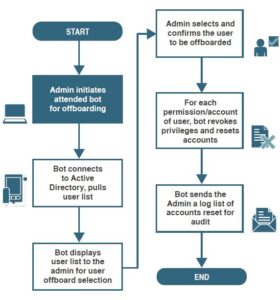Robotic Process Automation for onboarding and offboarding
Employee onboarding is a traditional human resource activity. It takes people and time. Using Robotic Process Automation for onboarding can shortcut the process.
Reading time: 2 minutes

Employee onboarding and offboarding are traditionally manual Human Resource activities, but as new technologies are introduced to take these processes online, automating repetitive tasks through RPA can simplify and streamline operations. The result: improved coordination and efficiency that empowers your HR team to do what they do best—attract, develop, and ultimately retain difference-making talent.
Why RPA?
Organizations typically adopt RPA for one of three reasons:
- They need to free up capacity.
- They need to reduce costs.
- They need to improve value and quality.
The bottom line: too many people spending time on labor intensive, repeatable tasks that do not add value, spur innovation, and drive business outcomes is bad for both the people and the business.
RPA for onboarding and offboarding
Many companies are currently benefitting from using RPA for HR. HR onboarding is a great example.
At one Global IT Firm, manual onboarding activities were reduced from 138 minutes per new employee to just 3 minutes. The bot integrated with HR employees to prompt them when needed. This bot also reduced the number of data entry errors.
BMW automated the empoloyee ID creation part of their onboarding process. This process interfaced with three systems. The bot was able to seamlessly integrate these systems, reducing manual time for new employee ID creation by 175 hours per month.
The following graphic depicts RPA running a user provision action.

The employee lifecycle
There are five-stages of the employee life cycle:
- Pre-Hire/Hire
- Onboarding
- Retention/Development/Discipline
- Employment Separation
- Post-Separation Issues
During the employee lifecycle, multiple departments must coordinate at each step to ensure a smooth employee experience.
RPA can help this coordination, specifically the onboarding and offboarding task. IT and HR can be automatically communicated with, improving connection and freeing up time for each department to engage in value-added activities.
The danger of lingering accounts
 At the end of an employee’s time with an organization, many companies do not have set processes to ensure accounts are closed. This can lead to security vulnerabilities that can be targeted by those outside of the organization—to get into the organization.
At the end of an employee’s time with an organization, many companies do not have set processes to ensure accounts are closed. This can lead to security vulnerabilities that can be targeted by those outside of the organization—to get into the organization.
With RPA, an HR employee can work with an attended bot to clean up and deprovision all the accounts for an employee who is leaving the organization. Additionally, this bot can be used to audit existing accounts to see if any accounts are lingering.
HR and IT do not need to have maintained an accurate list of all accounts and systems the employee had access to. Instead, the bot will locate accounts across systems and disable the account when found or skip a system the employee never had access to.


